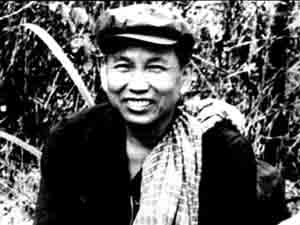The stack of human skulls piled high at Choueng Ek stands as gruesome testimony to the crimes of the Khmer Rouge. Thousands of black-and-white portraits at Toul Sleng offer yet more affirmation of the regime’s brutality. Then there is the court. The testimony. The tears.
Proof, it seems, could not be more conspicuous. But for the post-holocaust generation born after 1979, the stories of their elders are often too horrible to believe. Questions linger.
Is it really true?
That is the question posed by a group of Royal University of Phnom Penh (RUPP) students from this year’s graduating class. In a collection of short films of the same name, students from the department of media and communications explore life after the war, as lived by survivors.
“I would like to show these films abroad,” says Dr Tillman Baumgärtel, a visiting professor at RUPP Department of Media and Communications. “They give a different picture. It’s not the international filmmaker who comes here and shoots a movie in three weeks. It’s an on-the-ground perspective.”
For years, talk of the Khmer Rouge remained taboo. Prime Minister Hun Sen famously said the country should dig a hole and bury the past. The Extraordinary Courts of Cambodia, for all its failures, brought conversations about the country’s past into the fore. It proved a catalyst for bringing Khmer Rouge history into the high-school curriculum. The first history books to include Democratic Kampuchea landed on school desks in 2010. Until then, students had learned nothing of the brutality their parents endured.
Is it really true? answers the question not with documentary reportage but with short feature films. Some last only a few minutes, others longer. They strive for the same unbiased tone of television news, while tugging to unwrap the humanity of their protagonists.
In Grandma’s Story, the filmmaker’s grandmother tearfully recounts the day four Khmer Rouge soldiers came to take her husband away. They said he could have the same job he held under the Lon Nol regime. He left in a horse cart, and she never saw him again. Not all of the stories are so heart wrenching. Two films explore music, Khmer Music After Year Zero and The Chapei Saved My Life, which tells the story of chapei master Prach Chhoun.
In A Concrete Memory, filmmakers Ith Sothoeuth and Em Sopheak travel with historian Henri Locard to the abandoned airstrip at Kampong Chhnang, where they find an old-timer by the name of Som Chhamom. He is thin with sharp features and thick, calloused hands. In deliberate, unemotional sentences, he recounts the airport’s construction with the unhurried pace of the old. “Those soldiers still did most of the work manually,” he says, a long ribbon of concrete runway stretched out behind him. “They cleaned up everything here and filled in the holes.”
Under Chinese direction, Khmers built the 2,400-metre runway plus an elaborate underground tunnel network and above ground water storage facility – virtually all of it by hand. Estimates of the dead range from 10,000 to 50,000 – no one knows for certain. “The Chinese had further ideas about this place,” explains Locard. “We suspect it was to be not just a Khmer Rouge air base but a Chinese air base.” Some speculate that it was the nearing completion of the runway that finally prompted Vietnam to invade in early 1979, thus bringing an end to Pol Pot’s era of homicidal mania.
Only recently have Khmer artists, and the country at large, began to address the past in earnest. “I think the students learn a lot from it,” says Dr Baumgärtel. “Their generation already talked about this issue in school, but not at great length, so for them, they learn new things.”
Speaking from the runway in Kampong Chhnang, Som Chhamom offers his own ruminations. “[The] next generation should take care and keep it for future interest,” he says, the red krama around his neck fluttering gently in the afternoon breeze. He is talking about the airport, and the toll it took to build, but he could easily be talking about the modern state and its caretakers.
“Don’t let it get more damaged,” he says, “because this was not an easy thing to build.”
WHO: RUPP Department of Media and Communications graduating class
WHAT: Short films exploring life after the Khmer Rouge
WHERE: Meta House, 37 Sotheros Blvd.
WHEN: Friday May 11
WHY: KR tales told by survivors, not outsiders
